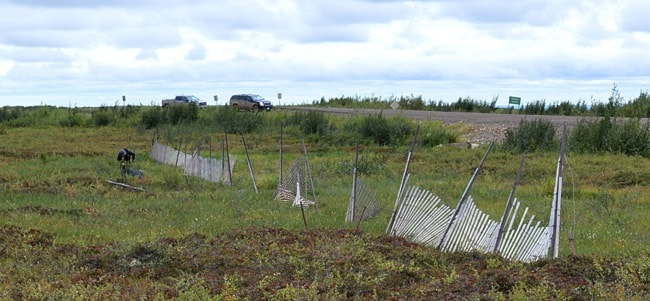Special to the News
It probably seemed like a good idea at the time. In the early 1980s, highway maintenance people in the Northwest Territories put up a stretch of snow fence along a drift-prone bit of the Dempster Highway on the Peel Plateau near Fort MacPherson. And then, it appears, they pretty much forgot it.
The metre-high fence stood there for three decades, snow building up around it in winter and melting away each spring. Its wooden slats dried and weathered until some of them broke, the wire holding them together sagged, and one stretch of fence collapsed completely.
That was the state of the fence in 2012, when Carleton University doctoral student Brendan O’Neill first saw it. O’Neill is researching the impacts of climate change on permafrost. He chose the area of the old snow fence as a study site in order to see how surface disturbance, such as the fence, affects the underlying permafrost. He reported his findings at the Annual Scientific Meeting of the ArcticNet research network in Vancouver in early December.
The study area is in the continuous permafrost zone, O’Neill says. In fact, deep under the more recent permafrost, there’s a thick layer of massive glacial ice that has been buried and frozen since the last ice age.
But the permafrost near the ground surface and under the old snow fence is what interests him. It’s melting, and it’s changing the landscape as it melts.
Every year since 2012, O’Neill and his colleagues have measured snow depth, ground temperature and permafrost depth near the old snow fence and at a control site at a distance from the fence. In addition, they have monitored conditions along a 40-metre transect, a line running across the snow fence at right angles.
The good news is that the snow fence works. It definitely traps the drifting snow. O’Neill recorded snow depth every two metres along the transect in March of each year. The snow cover varied from year to year, he says, but it was always deeper and accumulated earlier near the fence. At the ends of the transect, snow depth varied between 30 and 80 centimetres. At the fence, the snow piled as high as 1.2 metres, and it was usually at least a metre deep.
Every August, O’Neill returned to the site to measure how much of the ground had thawed over the summer. At the control site, the depth of the thaw was about 50 centimetres, but near and under the fence, the thaw ran dramatically deeper. In fact, O’Neill isn’t sure how far down the unfrozen ground goes, since he hasn’t been able to get a probe deep enough into the hard ground to reach it.
In 2015, he says, he brought a three-metre probe in the hope of reaching the frozen layer, but without any luck: “Unfortunately, the combined weight of two operators was insufficient to penetrate beyond 1.6 metres.”
The deepest he’s been able to reach beneath the fence is 1.75 metres. That was in 2013 when, as he says, he had “a rather large person” on his team. The ground at that depth was still unfrozen. Based on a computer model that incorporates his observations, O’Neill suspects that the thaw zone is at least three metres deep below the fence, or roughly six times the depth of thaw in the undisturbed zone.
The changes caused by the snow fence aren’t just below ground. The fence was erected on a fairly flat stretch of peatland beside the Dempster Highway, which is built up above the surrounding terrain. Today it looks quite different from the surrounding landscape.
In that area, O’Neill says, the ground is about 30 per cent ice, so when it thaws, water is released. Over the years the fence has been in place, the vegetation around it has changed from peatland plants to grass-like moisture-tolerant sedges. Over the same period, the ground has subsided. Instead of being surrounded by flat peatland, the fence now stands in a shallow, soggy bowl about half a metre deep.
And the subsidence is spreading. “We’re beginning to see some signs of subsidence on the side of the road along the fence,” O’Neill says. The fence that was erected to solve one highway problem, drifting, is now creating a new and possibly more expensive problem.
One lesson from O’Neill’s work is that the permafrost under the Peel Plateau is fragile and it doesn’t take much surface disturbance to trigger substantial changes. Another, O’Neill says, is that drainage is important, even if the site seems dry and frozen.
“If you have to build a snow fence, try to avoid building it in flat terrain,” he says. “Try to focus on a site with a slight slope or convex topography where you probably won’t have as big a problem.”
Claire Eamer moved to the Yukon in 1984 for a couple of years and finally got around to moving south (to Gabriola Island, B.C.) in 2015. Her latest book for kids, Before the World Was Ready: Stories of Daring Genius in Science, won the Lane Anderson Award for Young Readers, given for Canadian science writing.
